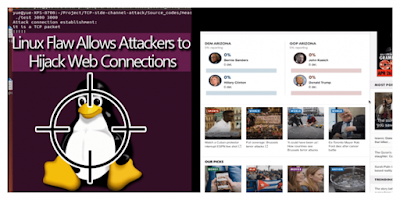Linux TCP Flaw Lets Hackers Hijack Internet Traffic And Inject Malware Remotely
Linux TCP Flaw Lets Hackers Hijack Internet Traffic And Inject Malware Remotely
College of California, Riverside, specialists have found a defenselessness in the Linux part that permits programmers to remotely send malware in the site page and download, to intrude on the association with the Tor, thus to do DoS-assaults et cetera.
The genuine mistake connected with the Transmission Control Protocol (TCP)/IP, which influences the portion, beginning with 3.6. With it, the aggressor can without much of a stretch figure out if to speak with each other over a system and any two frameworks require to interfere with the association between them or to present pernicious code transmitted activity, unless it is appropriately encoded.
Essentially there is no need of Man-in-the-Attack Position. An assailant could undoubtedly send uncommonly created parcels to both side channels of the compound, suffice it to know the customer's IP-address and the server, fundamentally, it helps aggressors to send them defenseless bundles.
System Model
System Model
As we as a whole realize that the TCP convention is the heart of all Internet associations, as all the application level conventions, including HTTP, FTP, SSH, Telnet, DNS, and SMTP, stand on TCP.
The defenselessness is identified with the execution of RFC-5961, it is a moderately new standard intended to ensure against digital assaults of a specific class. Be that as it may, for this situation, it is the reason for the issue. As clarified by the head of exploration Zhiyong Qian, a one of a kind element of this assault is that basically nothing is vital for its execution.
College of California, Riverside, specialists have found a defenselessness in the Linux part that permits programmers to remotely send malware in the site page and download, to intrude on the association with the Tor, thus to do DoS-assaults et cetera.
The genuine mistake connected with the Transmission Control Protocol (TCP)/IP, which influences the portion, beginning with 3.6. With it, the aggressor can without much of a stretch figure out if to speak with each other over a system and any two frameworks require to interfere with the association between them or to present pernicious code transmitted activity, unless it is appropriately encoded.
Essentially there is no need of Man-in-the-Attack Position. An assailant could undoubtedly send uncommonly created parcels to both side channels of the compound, suffice it to know the customer's IP-address and the server, fundamentally, it helps aggressors to send them defenseless bundles.
System Model
System Model
As we as a whole realize that the TCP convention is the heart of all Internet associations, as all the application level conventions, including HTTP, FTP, SSH, Telnet, DNS, and SMTP, stand on TCP.
The defenselessness is identified with the execution of RFC-5961, it is a moderately new standard intended to ensure against digital assaults of a specific class. Be that as it may, for this situation, it is the reason for the issue. As clarified by the head of exploration Zhiyong Qian, a one of a kind element of this assault is that basically nothing is vital for its execution.














No comments: